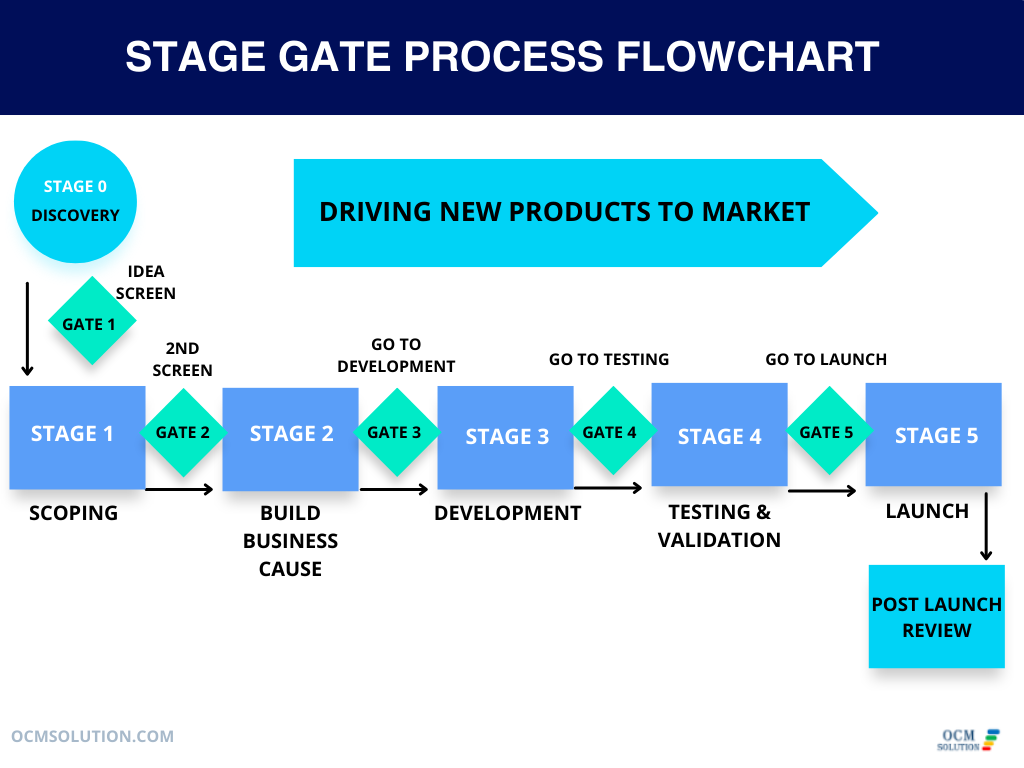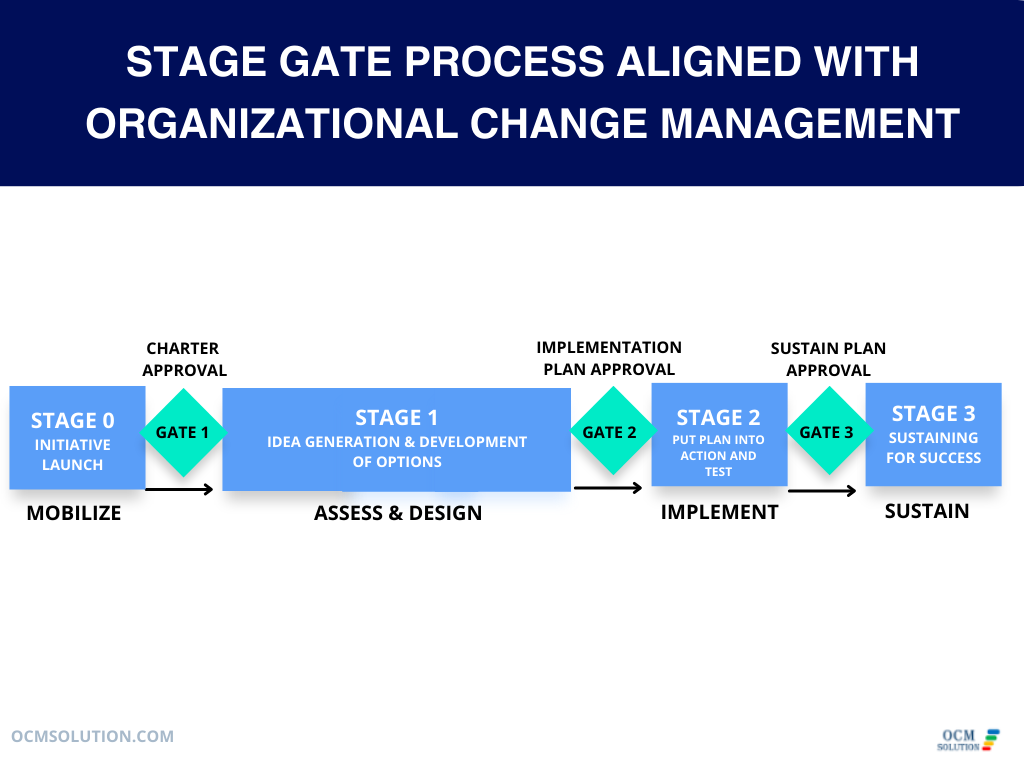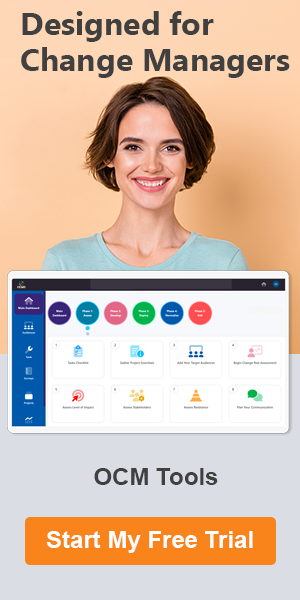Everything You Need to Know About Stage Gate Model in OCM & Project Management
Summary – Stage Gate Project Management
The Stage Gate Model in organizational change operates much like checkpoints in a marathon, ensuring that the race is run efficiently and effectively.
Each “stage” in this model represents a distinct phase of the change initiative, where specific activities and tasks are undertaken to progress the change.
After each stage, the initiative encounters a “gate”—a review point where critical assessments are made. Is the change progressing as planned? Are objectives being met? Do adjustments need to be made before moving forward? These gates act as quality controls, ensuring that the change initiative remains on track and that resources are used optimally.
By systematically working through stages and gates, organizations can implement change more strategically, reducing risks and enhancing the likelihood of achieving their desired outcomes.

Guide on Stage Gate in Project Management and Change Management
The stage gate process, a notable project management technique pioneered by Dr. Robert G. Cooper in the early ’80s, systematically breaks down a project into distinct, manageable stages, punctuated by decision points known as gates. At these gates, the project’s progress is critically evaluated against predefined benchmarks, determining whether the project should progress, be adjusted, or discontinued.
This method typically divides projects into stages such as Discovery/Ideation, Scoping, Business Case Development, Development, Testing and Validation, and finally, Launch/Implementation. Each gate represents a moment of reckoning, where key stakeholders examine the project’s current state, outcomes, and decide its onward trajectory.
The stage gate methodology is particularly prevalent in product innovation management. Its structured approach ensures only top-tier product ideas see the light of day, facilitating effective risk management, efficient resource allocation, and seamless goal alignment throughout the project lifecycle.
In organizational change management, the stage gate processes’ value becomes evident when it is applied to oversee transformation initiatives. This involves deconstructing the transformation into digestible stages, each characterized by unique objectives. The gates serve as critical junctures to measure progress, reinforce alignment with strategic objectives, and address potential risks.

Stage Gate Model
Innovatively, the agile stage gate hybrid model marries the rigorous structure of stage gate with the adaptability of Agile techniques. This enables organizations to adapt to changes promptly while maintaining transparency and governance over the change management process.
Furthermore, when the stage gate system is synergistically integrated with change management, it amplifies the efficacy of organizational transformation by guiding the creation of innovative solutions in line with the change objectives.
Utilizing a stage gate checklist template and other stage gate project management templates we have included can bolster the successful implementation of this process, serving as a reliable tool to track progress and ensure crucial activities and decision junctures are adequately addressed throughout the project.
See Also: The Best Change Management Framework for All Change Practitioners
Please reach out to our team if you have any questions about a gate phase process, or what a process gate looks like. We’ll be happy to help.
|
DETAILED SECTION |
|
If you’re eager to delve deeper into the world of stage gate change management and project management, proceed to our detailed sections below that provide a detailed overview. |
Table of Contents: Phase Gate in Project Management
Keep on scrolling down this page to read each section or click any link below to go directly to that section.
- Stage Gate Definition | What is a Stage Gate?
- History of Stage Gate Project Management | Introduction to Cooper Stage Gate Model
- What is Stage Gate Process?
- Stage Gate Project Management Methodology
- Stage Gate Project Management Phases | Project Management Stage Gates
- Project Management Gates
- How to Use Stage Gate Approach in Change Management
- Phase Gate Process Flow in Change Management
- Benefits of Stage Gate Process in OCM
- Agile Stage Gate Approach | Stage Gate vs Agile
- Embracing Agile Stage Gate in Change Management
- How to Enhance Change Management Effectiveness
- Stage Gate Checklist for Change Managers
- Conclusion | Stage Gate in Project Management and Change Management
- FAQ | What is Stage Gate Process?

Let us start this journey to stage gate processes by answering “What is a stage gate?”
Stage Gate Definition | What is a Stage Gate?
The stage gate definition describes it as a method that involves dividing a project into distinct stages or phases, separated by decision-making points known as gates.
It’s through these gates that the progress of a project is assessed before it can move to the next phase.
So, what is a stage gate meaning in this context?
Simply put, a stage gate or phase gate is a control point where the results or the performance of a stage are evaluated.
Now that we know what is a stage gate meaning, we can move to answer “What is stage gate process?”
What is the difference between stage gate vs phase gate?
The terms stage gate vs phase gate are often used interchangeably, as they both refer to a project management technique that divides the project into stages or phases separated by gates.
The exact terminology stage gate vs phase gate can vary based on industry, organization, or geographical location.
Before we get into details of the process, let’s find out how stage gate methodology came to life.
Please let us know if you have any questions about process gates or the stage gates process.
History of Stage Gate in Project Management | Introduction to Stage Gate Model Cooper
The origins of the stage gate model can be traced back to the early 1980s when Dr. Robert G. Cooper introduced his pioneering work on new product development practices – stage gate process for new product development.
Cooper’s stage gate process, as it’s commonly known today, originated from an era of great innovation, when companies were looking for methods to optimize their product development pipeline.
The stage gate model Cooper introduced revolutionized how companies approach the task of bringing new products to market.
Prior to the inception of this Cooper stage gate model, organizations were grappling with an array of challenges such as wasted resources, missed deadlines, and inadequate market response, largely due to a lack of structured, step-by-step development processes.
However, as stage gate model Cooper introduced was implemented more widely, companies began to see the true value in creating a process that was methodical yet flexible. The idea behind the Cooper stage gate model is not just to provide structure, but to encourage critical thinking and assessment at each juncture.

Dr. Robert G. Cooper Inventor of Stage Gate Project Management Process
As it is widely known, the Cooper stage gate model divides the stage gate process for new product development into distinct stages separated by decision gates.
This concept arose out of necessity, as Cooper noticed that the most successful projects didn’t happen spontaneously. Rather, they followed a step-by-step sequence, and this sequence was governed by a series of checks and balances – a critical factor that led to the development of Cooper’s stage gate process.
Over time, as the stage gate model Cooper proposed gained acceptance, it was further refined and adjusted to meet the evolving business landscape.
The continuous evolution and adaptability of Cooper stage gate model have cemented its position as a cornerstone of project management.
In the present day, Cooper’s stage gate process is a standard that many companies, both small and large, use for managing product innovation.
Next, we’ll go over the stage gate process definition.

Do you need more information what is phase gate in project management in general or building a gate phase process? Please reach out and let us know.
What is the Stage Gate Process? | Stage Gate Process Definition
When embarking on a project, it’s essential to comprehend what is the stage gate process (also known as phase gate process) and how it can significantly improve project management.
The stage gate process or phase gate process is a project management technique that breaks down the project into distinctive stages or phases, separated by decision-making gates.
To comprehend what is the stage gate process, imagine a project journey.
Each phase or stage of this journey involves a specific set of tasks or activities. Once these tasks are accomplished, the project reaches a phase gate where its progress and performance are evaluated against pre-established criteria.
This is the point where decisions are made on whether to move to the next stage, pause for modifications, or perhaps halt the project altogether.
Further understanding what is the stage gate process requires acknowledging its dynamic role in managing and mitigating project risks.
It helps organizations to keep close tabs on project evolution, ensuring that resources are efficiently used, and that the project stays aligned with its original goals and objectives.

What is Stage Gate Process?
When asking “what is stage gate process?” one might be looking for its practical application.
So, what is stage gate methodology or phase gate methodology?
Stage gate methodology applies across various industries and types of projects – be it stage gate product development, construction projects, or software development.
Stage gate methodology or phase gate methodology ensures that each stage of the project is meticulously carried out and assessed before proceeding further, enhancing both risk management and project performance.
The stage gate process definition revolves around this systematic, step-by-step approach that enables teams to concentrate on each stage independently while maintaining an overarching view of the entire project.
This ensures the in-depth completion of each phase while facilitating timely adjustments as per the project’s needs.
To sum it up, when we talk about “what is the stage gate process?” we are referring to a strategic project management approach that provides a structured pathway from project initiation to completion, adding efficiency and reducing risks.
Therefore, it is an invaluable tool for organizations aiming for effective project delivery and management.
With that covered, we should get deeper into the methodology.
Related: Everything You Need to Know about Agile Change Management – Agile & Scrum Change Management Framework
Do you have any questions or feedback about the stage gates process, gate phase process or creating process gates? Just let us know!
Stage Gate Methodology | What You Need to Know About Stage Gate Method
The stage gate method is a project management technique that helps manage and control the process of transforming a new product idea from its conception to its launch.
This method is named after the two key components of the process: stages and gates.
What are stages in stage gate processes? | Stage Gate Meaning
Stages are phases of the project that are crucial for the development of the product – stage gate product development process.
These stages can involve activities such as initial exploration, building a business case, development, testing, and final validation.
Each stage consists of a set of predetermined activities that must be completed before moving on to the next stage. The output of these activities are stage gate deliverables that are then reviewed at the subsequent gate.

Stage Gate Meaning – Project Management Stage Gates
What are gates in stage gate processes? | Stage Gate Meaning
Gates serve as decision points in the project lifecycle. They are points where the project’s progress and performance are critically evaluated.
The gate is where the decision is made to either move the project forward to the next stage, redirect it, hold it, or stop it based on the information available at the time.
The stage gate method is incredibly valuable for organizations because it helps ensure that only the best product ideas are developed and brought to market.
By providing a structured stage gate process, the stage gate method reduces the risks associated with product development and increases the chances of launching a successful product stage gate process for new product development).
What is a gate review in project management?
A gate review in project management is a checkpoint at which project progress is evaluated and the decision is made whether to move forward to the next phase or not.
Stage gate project management methodology allows for careful planning, coordination, and review of all aspects of a project, providing a pathway to align the project’s objectives with the strategic goals of the organization.
This can save an organization time and resources and lead to better decision-making throughout the stage gate product development process.
Please let us know if you have feedback on this process gate and gate phase process article. We’d love to hear your thoughts!
Stage Gate Project Management Phases | Project Management Stage Gates
The stage gate model is a popular methodology that divides the project into different stages, separated by decision-making gates.
Below are the typical stages in the stage-gate model:
Stage 0 – Discovery or Ideation Stage of Phase Gate in Project Management
This is the initial stage of the stage gate approach where ideas for the project are gathered and evaluated.
It’s an open stage of the stage and gate process where creativity is encouraged to identify potential project opportunities.
Stage 1 – Scoping or Preliminary Assessment Stage of Project Management Stage Gates
In this stage of the stage gate system, the project is briefly outlined and preliminary research is conducted.
Stage gate process example could include:
- initial market analysis
- technical assessment, and
- a rough estimate of the project’s feasibility and potential profitability.
Stage 2 – Business Case Development Stage of Stage Gate Process for New Product Development
At this point of the stage gate approach, a detailed business case is developed.
This stage of the stage gate system typically includes:
- a more thorough market analysis,
- technical appraisal,
- operational feasibility assessment,
- financial analysis, and
- risk assessment.
The objective of this phase of the stage gate framework is to ensure the project aligns with the organization’s strategy and goals and that it has potential for success.
Stage 3 – Development Stage of Stage Gate Product Development Process
In development stage of the phase gate model, the project is officially launched internally.
Stage gate process example of development phase includes:
- the product being designed and developed,
- outlining marketing strategies,
- planning operations and production systems, and
- detailing launch or implementation plans
Stage 4 – Testing and Validation Stage of Project Management Stage Gate Process
Testing and validation phase of the stage gate in project management involves rigorous testing of the product and the project plan.
For a product, it might include both technical or quality tests and market testing.
For other types of stage gate project management, it might involve pilot programs or dry runs.
The goal of this phase of the stage gate model is to ensure that the project is ready for full-scale launch or implementation.
Stage 5 – Launch or Implementation Stage of Stage Gate Process in Project Management
Launch or implementation stage of the stage gate process is the final stage where the project is fully implemented or the product is introduced to the market.
This phase of project stage gate process involves the execution of all the strategies and plans developed in the previous stages.
Understanding and implementing the stage gate project management process phases can lead to more effective management of projects, reducing the risks and increasing the chances of success.
We’re going to look at project management gates and project gates examples next.
Do you have any further input on stage gate process in project management or creating a process gate workflow? Just reach out and let us know.
Project Management Gates | Decision Gates in Project Management
Gates in the stage gate approach are crucial decision points or checkpoints that occur at the end of each stage in a project’s lifecycle.
At each gate between stages, the progress, outcomes, and forecasts of the project are reviewed.
The primary purpose of these gates in the stage gate framework is to determine whether it is feasible and beneficial to move forward with the project.
Decision gates in project management can lead to four potential paths for the project:
- Go (move to the next stage),
- Kill (stop the project),
- Hold (delay the project), or
- Recycle (revise the project plan or product and repeat the current stage).
Let’s delve into the functions of each decision gate/ governance gate in project management in each stage of the stage gate model:
Gate 1 – Decision Gate After Discovery/Ideation Stage
This gate in the stage gate processes aims to assess the viability of the initial idea based on preliminary data and information.
The goal of this project management gate of the stage gate processes is to determine if the idea aligns with the organization’s strategic goals and if it seems feasible based on the current market and technical environment.
Gate 2 – Decision Gate After Scoping Stage
At this gate of the stage gate processes, the results of the initial scoping or preliminary assessment are reviewed.
Decision gate after scoping aims to evaluate the feasibility and potential profitability of the project based on the preliminary analyses and to decide whether it’s worth advancing to a more detailed investigation phase.
Gate 3 – Decision Gate After Business Case Stage
This gate of the stage gate in project management reviews the business case developed during the previous stage.
It’s a critical decision point of the phase gate in project management where the project’s alignment with strategic goals is reassessed, and a decision is made whether to commence the development phase.
Gate 4 – Decision Gate After Development Stage
This gate of the stage gate processes evaluates the development outcomes.
This decision gate project management assesses whether the project’s development objectives have been met and whether it’s ready for the testing phase of project stage gates.
Gate 5 – Gate After Testing and Validation Stage
The results of the testing and validation stage are reviewed at this project management gate.
At this project management gate, the entire project is assessed to see if it meets the established success criteria and if it’s ready for a full-scale launch or implementation.
Gate 6 – Gate After Launch Stage
This is the final gate of the project management gate process, where the performance of the project or product in the market or within the organization is reviewed.
This project management gate in the stage gate processes looks at the initial project objectives and the actual outcomes to understand the success of the project and to gather learnings for future projects.
Each of the project management gates of the stage gate processes involves a review by key stakeholders, who use predetermined criteria to evaluate the project’s progress and potential.
The structured decision-making process at these project stage gates helps ensure that resources are allocated wisely and that only the most promising projects continue through to completion.
What should a project gate review template contain?
Let’s take a look at what a project gate review template should contain.
This is a general template and you may need to customize it to fit your organization’s specific requirements.
| Review Criteria |
Description |
Status |
| Gate Name | e.g., Gate 1 – Gate 1 Name | – |
| Project Alignment | Is the project still aligned with organizational strategic goals? | Complete/In Progress/Not Started |
| Scope Validation | Has the project scope been reviewed and validated since the last gate? | Complete/In Progress/Not Started |
| Risk Review | Have all new risks been identified and mitigation plans been updated? | Complete/In Progress/Not Started |
| Resource Availability | Are the necessary resources available to proceed to the next phase? | Complete/In Progress/Not Started |
| Deliverable Review | Have all deliverables been completed satisfactorily for the current phase? | Complete/In Progress/Not Started |
| Stakeholder Feedback | Is there positive feedback from stakeholders and has their input been incorporated? | Complete/In Progress/Not Started |
| Next Phase Plan | Is the plan for the next phase well-detailed and ready for implementation? | Complete/In Progress/Not Started |
| Reviewer Notes | Summary of overall gate review findings, including any major issues and recommendations for going forward. |
This way, the project management stage gates provides a roadmap for managing risk, maintaining strategic alignment, and achieving project success.
Additionally, you can utilize project management tools to track your project management stage gates.
Next, we’ll take a look at stage gate process flow chart to see how stage and gate process comes together.
Do you have any questions about project stage gate process or ? Don’t hesitate to reach out and let us know.
Stage Gate Process Flowchart | Project Management Stage Gate Process
Now that we went through all individual stages and gates, it’s time to take a comprehensive look at it in the form of stage gate process flowchart.

Stage Gate Process Flow Chart – Project Management Stage Gate Model Example
Each stage (0 to 5) represents a point where a set of related activities occur.
Each gate, in turn, is a decision point where the progress and outcomes of the previous stage are evaluated, risks are assessed, and a decision is made to proceed to the next stage, to redirect the project, or to abandon the project.
To further elaborate on this stage gate process flowchart, we have also prepared a handy overview in the table format.
|
Stage/Gate |
Description |
| Stage 0: Discovery or Ideation |
Generate and evaluate project ideas; encourage creativity and potential project opportunities. |
| Gate 1: After Discovery/Ideation Stage |
Assess viability of the initial idea using preliminary data; align idea with organizational and market feasibility. |
| Stage 1: Scoping or Preliminary Assessment Stage |
Outline project; conduct preliminary research, market analysis, technical assessment; estimate project’s feasibility and profitability. |
| Gate 2: After Scoping Stage |
Review results of initial scoping; evaluate project feasibility and profitability; decide on the advancement to the detailed investigation phase. |
| Stage 2: Business Case Development Stage |
Develop a detailed business case including thorough market analysis, technical appraisal, operational feasibility, financial analysis, and risk assessment. |
| Gate 3: After Business Case Stage |
Review business case; reassess project’s alignment with strategic goals; decide on the commencement of the development phase. |
| Stage 3: Development Stage |
Launch the project internally; design and develop the product; outline marketing strategies; plan operations and production systems; detail launch or implementation plans. |
| Gate 4: After Development Stage |
Evaluate development outcomes; assess whether development objectives have been met; decide on the readiness for the testing phase. |
| Stage 4: Testing and Validation Stage |
Perform rigorous testing of the product and the project plan; ensure that the project is ready for full-scale launch or implementation. |
| Gate 5: After Testing and Validation Stage |
Review results of the testing and validation stage; assess if project meets the established success criteria; decide on the readiness for a full-scale launch or implementation. |
| Stage 5: Launch or Implementation Stage |
Fully implement the project or introduce the product to the market; execute all the strategies and plans developed in previous stages. |
| Gate 6: Gate After Launch Stage |
Review project or product performance; compare initial project objectives with actual outcomes; gather learnings for future projects. |
Stage Gate Process Example – Project Management Stage Gates
Please note that this is a basic stage gate model example and the exact model used by a company can vary based on their specific needs and project requirements.
With a clear understanding of stage gate in project management, now we can move to stage gate change management process.
Let’s see how phase gate in project management can be aligned with organizational change management.
Ready? Let’s go!

Popular Article: What You Need to Know about Prosci Change Management
How to Use Project Management Stage Gates in Organizational Change
The stage gate system, a proven and widely-used project management technique, can be effectively employed in the field of change management.
Organizational change often poses complex challenges, and utilizing a structured, systematic approach like the stage gate process can help manage this complexity by breaking down the transformation into manageable stages separated by decision gates.
Each stage represents a phase in the change process and has distinct objectives, while the gates serve as checkpoints to assess progress, ensure alignment with strategic goals, and mitigate risks.
This stage/phase gate model enhances transparency and promotes rigorous scrutiny, thereby increasing the probability of successful change implementation.
Another factor that makes phase gate approach suitable for organizational change management also adaptive, allowing for adjustments and recalibrations based on ongoing evaluations.
Below we have outlined how the stage gate processes can be adapted to align with change management, detailing the key activities and objectives in each stage and gate.
This stage gate process template can serve as a foundation for your own stage-gate process.
Each stage and gate should be fleshed out in detail with all relevant information, responsibilities, and decision criteria specific to your organization’s needs and the particular change initiative.
| Stage/Gate | Description | Key Activities/OCM Stage Gate Deliverables | Outcomes |
| Stage 0: Mobilize |
Initial stage where the need for change is identified and initial hypotheses about the potential benefits and impact of the change are formulated. | Recognize the need for change, formalize the scope of change, assign leadership roles, establish the change management team. | Direction and tone of the initiative are set, scope of change and roles are defined. |
| Gate 1: Charter Approval |
A checkpoint where initial planning and hypotheses are reviewed. | Review of initial planning and hypotheses by senior management or project governance board, identify potential risks, develop mitigation plans. | Change initiative is confirmed to align with the organization’s overall strategic goals and is given a solid foundation to proceed. |
| Stage 1: Asses & Develop(Stage 1.1: Assess) |
Deep dive analysis of the current state of the organization, compared with the desired future state and industry best practices. | Evaluation of the organization, processes, and systems, comparison with future state and best practices, refinement of the initial idea based on data and insights. | Detailed vision of the future state is created, serving as a guiding beacon for the change initiative. |
| Stage 1: Asses & Design(Stage 1.2: Design) |
Creation of potential action plans to facilitate desired changes. | Develop and assess multiple options based on their feasibility, impact, and strategic alignment, ‘pressure test’ options with frontline employees and stakeholders. | Most promising options for change are chosen for further testing and development of detailed implementation plans. |
| Gate 2: Implementation Plan Approval |
Review of the detailed implementation plan and chosen change options. | Review of implementation plan and change options, check for practical viability, alignment with change initiative goals, and resource readiness. | Confirmation that the plan is ready for implementation, all necessary resources are in place for the next phase. |
| Stage 2: Implement |
Approved changes are put into action. | Implement the changes, often starting with a pilot phase, communicate changes, build necessary capabilities, work on changing behaviors, start tracking progress against the plan. | Changes are in motion, ongoing reporting, quality assessments, and risk management activities begin. |
| Gate 3: Sustain Plan Approval |
Checkpoint where the outcomes of the implementation are reviewed. | Review outcomes of implementation, ensure changes are yielding expected results and progressing according to plan, check readiness to sustain changes. | Confirmation that the organization is ready to sustain the changes in the long term. |
| Stage 3: Sustain |
Final stage where the impact of the change is solidified and the lessons learned are captured. | Ensure the changes are fully integrated into regular operations, capture lessons learned. | Changes are embedded in the organization’s operations, marking the transformation’s success. Initiative team is decommissioned. |
Stage Gate Process Template for OCM – Aligning Stage Gate Processes With OCM
Creating a stage gate process template can be quite effective for visualizing and structuring your change management strategy.
You can use the above table as your initial stage gate process template and build upon it to better suit your organization’s change needs.
From recognizing the need for change and designing the change plan, to implementing the changes and ensuring they are sustained in the long term, the stage gate model provides a comprehensive and structured approach.
With its focus on regular evaluations, risk management, and continuous learning and adaptation, the process equips organizations with the necessary tools to navigate the complexities of change and facilitates successful organizational transformations.
If you’re more of a visual type, stick around as next we’re going to take a look at stage gate process flowchart that’s been adapted for organizational change management.
Do you have any questions about stage gate in project management or creating process gates? Please reach out and let us know. We’ll love to hear from you.
Stage Gate Process Flowchart Adapted for OCM | Phase Gate Process in Change Management
The change management stage gate processes presented in the below stage gate process flowchart follow a systematic, stage-gate approach adapted to ensure a structured and effective way to navigate organizational change.
The flowchart stage gate example clearly delineates each stage and governance gate in project management, ensuring everyone involved in the project understands their roles and the sequence of actions required for successful change management.

Stage Gate Change Management – OCM Stage Gate Process Flow Chart
It’s important to note that the stage gate management process depicted in the above flowchart represents just one way in which the stage gate framework can be aligned with change management.
While it provides a robust and structured approach, the application of the stage and gate process can vary greatly based on the specific needs and context of each organization or project.
Organizations may adapt the phase gate model to best suit their strategic goals, internal processes, or industry requirements.
They may add or remove stages or gates, or modify the criteria for progression through each project gate process.
Some organizations might also combine this with other project management or change management methodologies to create a hybrid approach that leverages the strengths of multiple models. We’ll talk more about agile stage gate hybrid model later on it the article.
The critical aspect is to maintain the principle of staged progression with decision points (gates), as this ensures effective risk management, alignment with strategic goals, and facilitates a focus on learning and adaptation.
Despite the potential variations in implementation, the systematic and iterative nature of stage gating remains a valuable framework for managing organizational change, increasing the chances of successful transformation.
Ready to learn about benefits of stage gate method in change management. Let’s do it!
Related: What You Need to Know about the ADKAR Model & Prosci’s ADKAR Methodology
Benefits of Stage Gate Process in OCM
The stage-gate processes can significantly enhance Organizational Change Management (OCM) by providing a structured framework for overseeing and controlling the evolution of changes within an organization.
Below are some of the benefits of stage gate process in change management:
⋅ Improved Decision Making: The phase gate/stage gate processes introduce regular decision points (gates), where the progression of the change initiative can be evaluated.
This facilitates informed and timely decision making based on evidence and defined criteria.
Stage gate example: If a change initiative aimed at implementing a new IT system isn’t delivering the expected benefits during the ‘Implement’ stage, the initiative can be reassessed or even halted at the subsequent project gate process to avoid further unnecessary expenditure.
⋅ Risk Management: Stage gating encourages risk identification, assessment, and mitigation at each stage and gate process, thus reducing the likelihood of unexpected challenges during the implementation of changes.
Stage gate examples could be, for instance, if potential risks related to resistance from employees are identified during the ‘Assess’ stage, measures such as additional communication or training can be introduced to mitigate this risk.
⋅ Alignment with Strategic Goals: The stage gate system ensures that all change initiatives align with the organization’s strategic objectives.
This alignment is reassessed at each gate, keeping the project on track and aligned with the organization’s strategy.
Project gates examples could include something like the following project management stage gate process scenario. If a company’s strategic goal is to improve customer service, a change initiative aimed at streamlining internal communication processes will be checked for alignment with this goal at every gate.

Stage Gates Process | Benefits of Stage Gating in OCM
⋅ Enhanced Communication: With a clearly defined process and stages, it is easier to communicate the progress and direction of the change initiative to all stakeholders, which can increase engagement and reduce resistance.
Stage gate examples could include knowing that a change initiative is moving from the ‘Design’ stage to the ‘Implement’ stage can help employees prepare for the upcoming changes.
⋅ Increased Efficiency: The structured nature of the project stage gate process encourages efficient use of resources, as decisions to progress to the next stage are based on thorough assessments and defined success criteria.
Stage gate process example: A change initiative that does not pass ‘Gate 2 – Implementation Plan Approval’ might be sent back for further refinement, thus avoiding the wastage of resources on a poorly planned implementation.
⋅ Promotion of Continuous Learning: The stage gate framework inherently promotes learning and continuous improvement as lessons learned at each stage and gate can inform future change initiatives.
For example, if it was identified at the ‘Sustain’ stage that more robust communication was needed during the ‘Implement’ stage, this learning could be applied to future projects.
Thus, the phase gate model in change management offers a systematic and disciplined approach to managing and executing change initiatives, enhancing their likelihood of success and minimizing the risks associated with organizational change.
With stage gate change management benefits covered, let’s take a look at agile stage gate hybrid model.

Read More: Is John Kotter’s 8-Step Change Model Still Relevant?
Agile Stage Gate Approach | Stage Gate vs Agile
The agile stage gate hybrid model blends traditional stage gate process in project management with agile principles
Agile stage gate blend brings together the structure and rigor of the project stage gates approach with the flexibility and responsiveness of agile methodologies.
Traditional Stage Gate vs Agile
In traditional project management gate process, each project stage is followed by a decision project management gate process where the project’s progress is evaluated based on specific criteria.
Decisions are then made about whether to proceed, pause, or terminate the project.
The agile stage gate process, however, introduces iterations and flexibility within each stage, accommodating changes based on the lessons learned during the project’s lifecycle.
Contrasting the traditional stag gate and agile approaches, it becomes evident why a hybrid phase gate model might be appealing.
Traditional phase gate model, while providing a clear and structured project roadmap, can sometimes struggle with inflexibility and sluggishness, particularly when facing unexpected changes or obstacles.
On the other hand, agile approaches, with their emphasis on flexibility, iteration, and stakeholder feedback, can sometimes lack the structure and oversight needed for more complex projects or stricter regulatory environments.
Don’t Miss: Guide for Managing Resistance to Change in Organizations
Do you have any input on project management gate review that we haven’t mentioned? If so, don’t hesitate to get in touch.
Embracing Agile Stage Gate in Change Management
In the context of organizational change management, the integration of Agile and Stage-Gate methodologies can offer a robust framework to facilitate effective change. The Agile Stage-Gate approach represents a paradigm shift in change management, blending the predictability and structure of Stage-Gate models with the responsiveness and flexibility of Agile principles.
Agile Phase Gate – Structure Meets Adaptability
The core advantage of this hybrid model lies in its ability to balance structure with adaptability.
The stage gate model example, renowned for its disciplined approach to project management, offers a systematic framework for managing change.
Each stage of the change process is punctuated by project management gate process, where the progress of the change initiative is assessed and decisions are made on whether to continue, adjust or halt the initiative.
This methodical structure brings visibility, control, and a high degree of predictability to the change management process.
Conversely, agile methodologies, characterized by their iterative and flexible nature, allow organizations to respond swiftly to changes in their internal or external environment.
Agile fosters a culture of ongoing feedback and continuous improvement, enabling organizations to adapt their change strategy in real-time based on the evolving needs and feedback from stakeholders.
The Synergy of Agile and Stage Gating in Change Management
By integrating these two methodologies, organizations can navigate the change management process with the best of both worlds: the structure and visibility provided by stage gate, and the responsiveness and flexibility of agile.
During each stage of the change process, agile practices can be employed to drive the work. This could mean adopting Scrum or Kanban methodologies to manage tasks, enabling the change team to adapt quickly to emerging needs or challenges.
At the conclusion of each Agile cycle or sprint, the team would arrive at a project management gate, where the progress of the change initiative is evaluated.
The use of these project management gates ensures that the change initiative remains aligned with the overall strategic objectives, and any potential risks or issues can be addressed promptly.
In the section below, we’ll give you some ideas on how to enhance change management effectiveness.

Popular Article: Ultimate Guide to Stakeholder Management & Engagement
Stage Gate Innovation | How to Enhance Change Management Effectiveness
The project phase gate model isn’t just a powerful tool for change management; it’s also widely recognized as a valuable framework for driving innovation within an organization.
When stage gate innovation is aligned with the change management process, it can amplify the effectiveness of organizational transformation efforts.
Innovation through the Project Phase Gate Lens
At its core, the stage gate development process for innovation involves a systematic approach to developing new products or services from initial idea generation to final market launch.
Stage gate development process is separated by gates, which serve as decision points where the project’s progress is assessed and the decision to continue, adjust, or terminate the project is made.
This methodical approach provides a structured path for innovation, ensuring that all new ideas are thoroughly vetted and developed before they’re launched.
Moreover, the gate reviews provide opportunities to assess the alignment of the innovative product or service with the company’s strategic goals, thereby ensuring that the stage gate innovation supports the broader business objectives.

How to Align Stage Gate Innovation with Change Management
Aligning Stage Gate Innovation with Change Management
In the context of change management, phase gate innovation can be seamlessly integrated into the process.
As the organization goes through the various stages of change – from recognizing the need for change, designing the change, implementing it, and then sustaining it – the innovation stage gate process in project management can be used to guide the development of innovative solutions to drive the change.
For example, suppose the change involves introducing a new technology or process within the organization. In that case, the stage gate management can guide the development of this new technology, from initial concept to final implementation.
The decision gate project management serves as checkpoint to ensure that the new technology aligns with the overall change goals, is feasible, and can deliver the expected benefits.
Moreover, integrating agile principles into this process can further enhance its effectiveness. By adopting an agile approach to phase gate innovation, organizations can ensure that the development process is flexible and responsive, capable of adapting to changes in the market or the internal environment.
To make sure you have it all covered, don’t miss the stage gate checklist template below.
Do you have any questions or input about stage gate process for new product development we provided? Just reach out and let us know.
Stage Gate Checklist for Change Management
Managing change can be a complex process, often marked by many variables and uncertainties.
In such a situation, using a structured approach such as project stage gates can provide a clear roadmap for change, helping to guide an organization from the initial recognition of the need for change to the successful implementation and institutionalization of that change.
This stage gate checklist we’re providing encapsulates the key activities and decision points within the project management stage gate process.
Stage gate checklist template is designed to serve as a useful tool for project managers and change leaders, providing a comprehensive overview of the process, and a structured means to track progress.
Stage Gate Checklist Template
Mobilize (Stage 0)
- Identify the need for change and its triggers
- Define the scope of the change, including specific deliverables and metrics
- Formulate initial hypotheses about potential benefits and impact of the change
- Assign leadership roles (e.g., Initiative Sponsor, Lead)
- Establish the change management team
Gate 1 – Charter Approval
- Review initial planning and hypotheses
- Ensure alignment with the organization’s strategic goals
- Identify potential risks and develop mitigation plans
- Obtain charter approval from senior management or project governance board
Assess & Design (Stage 1)
- Evaluate the current state of organization, processes, and systems
- Compare current state with desired future state and industry best practices
- Refine and frame the initial idea for the change based on collected data and insights
- Create a detailed vision of the future state
- Design potential action plans, develop and assess options for feasibility, impact, and alignment with strategic goals
- Select the most promising options for further testing and development of implementation plans
- Pressure test the options with frontline employees and stakeholders
Gate 2 – Implementation Plan Approval
- Review the detailed implementation plan and chosen change options
- Check that the plan is viable, still aligns with the change initiative’s goals, and that necessary resources are in place
- Obtain implementation plan approval
Implement (Stage 2)
- Execute the approved changes, starting with a pilot phase if necessary
- Communicate the changes, build necessary capabilities, and work on changing behaviors
- Begin tracking progress against the plan through ongoing reporting, quality assessments, and risk management activities
Gate 3 – Sustain Plan Approval
- Review the outcomes of the implementation
- Ensure that the changes are yielding the expected results and progressing according to plan
- Verify that the organization is ready to sustain the changes in the long term
- Obtain sustain plan approval
Sustain (Stage 3)
- Solidify the impact of the change and capture lessons learned
- Ensure changes are fully integrated into the regular operations of the business
- Decommission the initiative team, ensuring that the new way of working has been embedded into the organization’s DNA.
Remember, this stage gate checklist should be adjusted to fit the specific needs and context of your project and organization. It’s a dynamic tool that can evolve as the project progresses.
Conclusion: Stage Gate in Project Management and Change Management
In exploring what is stage gate in project management and change management, it’s clear that its systematic structure is key to successful project delivery and organizational change.
The phase gate process divides complex projects into manageable stages, each followed by rigorous gate reviews to ensure alignment with strategic objectives.
We highlighted how the Cooper’s stage gate process can be fused with agile methodologies to create a hybrid model that offers the best of both worlds – the dynamism of agile with the structured control of stage gate project management process.
This represents a novel approach in change management, enhancing an organization’s adaptability to market and internal shifts.
In summary, whether your organization is launching a project, new product, implementing strategic change, or nurturing innovation, the project gate process can be a valuable tool.
However, the power of the process lies not just in its structure, but also in its adaptive application within the unique context of your organization.
Through understanding and customization, the what is phase gate in project management can effectively steer any project or change initiative towards success.
Good luck!

Are you looking for more information about phase gate in project management and change management? Get in touch and let us know!
FAQ: Stage Gate Development Process
What is phase gate in project management? What is stage gate in project management?
The stage gate definition describes it as a method that involves dividing a project into distinct stages or phases, separated by decision-making points known as gates.
It's through these gates that the progress of a project is assessed before it can move to the next phase.
What is change control board in project management?
Change control board in project management is responsible for evaluating change requests.
Change control board typically comprises representatives from various departments, including IT, operations, finance, and management.
What are stages and gates in Cooper’s stage gate product development process?
Here are the stages and gates in Cooper’s stage gate product development process.
Stage 0: Discovery
Gate 1: Initial Screen
Stage 1: Scoping
Gate 2: Second Screen
Stage 2: Build Business Case
Gate 3: Go to Development
Stage 3: Development
Gate 4: Go to Testing
Stage 4: Testing and Validation
Gate 5: Go to Launch
Stage 5: Launch
Gate 6: Post-Launch Review
What are some useful stage gate project management templates?
Useful stage gate project management templates include:
• stage gate process template
• stage gate checklist template, and
• project gate review template
Note: Content on OCM Solution's ocmsolution.com website is protected by copyright. Should you have any questions or comments regarding this OCM Solution page, please reach out to Ogbe Airiodion (Change Management Lead) or the OCM Solutions Team today. OCM Solution was previously known as Airiodion Global Services (AGS).
External sources: stock.adobe.com, www.linkedin.com/in/dr-robert-g-cooper-3999b779

